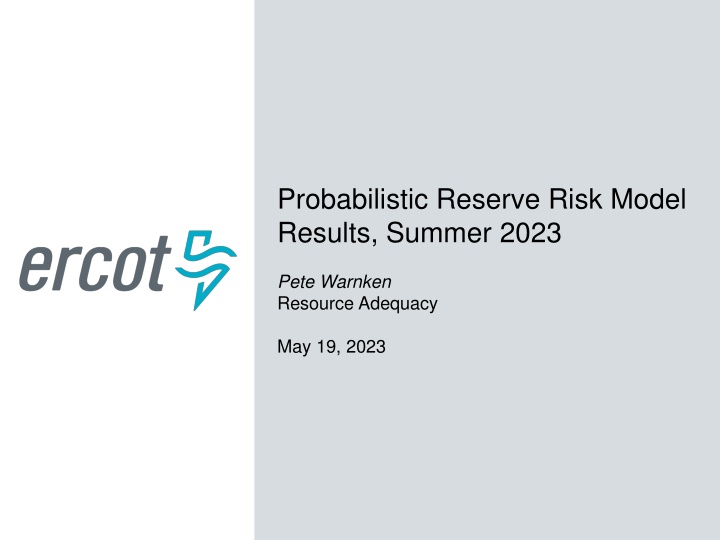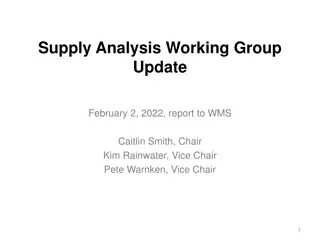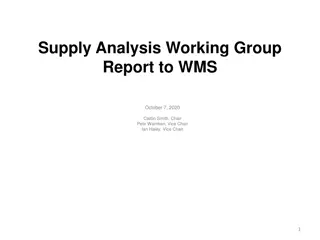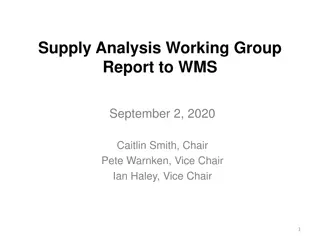
Energy Emergency Alert Risk Profile - Summer 2023 Updates
Explore the updated probabilistic reserve risk model results for Summer 2023, focusing on capacity available for operating reserves, probabilistic version of CAFOR, and model enhancements. Learn about key risk measures, uses of reserves, and model adjustments for addressing higher-than-expected peak demand scenarios. Stay informed about the latest developments and preparations for potential energy emergencies.
Download Presentation

Please find below an Image/Link to download the presentation.
The content on the website is provided AS IS for your information and personal use only. It may not be sold, licensed, or shared on other websites without obtaining consent from the author. If you encounter any issues during the download, it is possible that the publisher has removed the file from their server.
You are allowed to download the files provided on this website for personal or commercial use, subject to the condition that they are used lawfully. All files are the property of their respective owners.
The content on the website is provided AS IS for your information and personal use only. It may not be sold, licensed, or shared on other websites without obtaining consent from the author.
E N D
Presentation Transcript
Probabilistic Reserve Risk Model Results, Summer 2023 Pete Warnken Resource Adequacy May 19, 2023
EEA Risk Measure: Capacity Available for Operating Reserves (CAFOR) CAFOR Formula: = Seasonal Maximum Expected Resource Generation Capability Demand Uses of Reserves* + Pre-EEA Resources if CAFOR < 3,000 MW + EEA Resources if CAFOR < 2,300 MW * Uses of Reserves: Higher-than-expected peak demand Thermal unit outages Renewable generation below expected values 2 ERCOT Public
Probabilistic Version of CAFOR CAFOR Formula: = Seasonal Maximum Expected Resource Generation Capability for Thermal and Hydro Resources + Random draw from hourly capacity probability distributions for the following resources: Wind and Solar PUN generator net imports Net Peak demand, random draw from hourly capacity probability distribution less Price Responsive Demand from supply schedule Unplanned thermal outages, random draw from daily capacity probability distribution + Pre-EEA Resources* if CAFOR < 3,000 MW + EEA Resources if CAFOR < 2,300 MW * Random draws for remaining DC tie net imports and emergency requests for Switchable Generation Resources capacity committed to other grids 3 ERCOT Public
Model Updates Included hour-ending 9 PM to show the reserve risk when solar production is negligible Assumed that a portion of 4CP participation as documented in the 2022 Annual Report of Demand Response is not reflected in the summer 2023 load forecast, and is available to further reduce load during peak demand days Range of Price Responsive Demand in the model is 419 MW to 3,192 MW Created a version of the model with the proposed new EEA triggers in NPRR1176 Model aligns with the summer-rated thermal resource capacity in the Summer 2023 SARA report; wind and solar profiles scaled to match SARA installed capacities New synthetic hourly wind and solar profiles, which include those reflecting 2022 weather, are nearly ready for use; a final set of profiles is expected by the end of May 4 ERCOT Public
Energy Emergency Alert Risk Profile Hourly Risk Profile, Probability of EEAs (%) 1:00 PM 2:00 PM 3:00 PM 4:00 PM 5:00 PM 6:00 PM 7:00 PM 8:00 PM 9:00 PM Probability of Reserves being equal to or less than 3,000 MW 0.112 1.254 2.434 2.755 3.867 4.609 9.746 21.406 28.552 Probability of Reserves being equal to or less than the 2,300 MW EEA1 threshold 0.018 0.201 0.344 0.523 0.916 1.079 3.120 9.301 16.581 Probability of Reserves being equal to or less than the 1,750 MW EEA2 threshold 0.015 0.095 0.227 0.312 0.557 0.721 2.282 7.539 14.427 Probability of Reserves being equal to or less than the 1,430 MW EEA3 threshold 0.013 0.086 0.184 0.224 0.431 0.605 1.881 6.574 13.141 Probability of Reserves being equal to or less than the 1,000 MW load shed threshold 0.011 0.080 0.157 0.170 0.324 0.473 1.489 5.432 11.500 5 ERCOT Public
Impact of Applying New EEA Triggers (NPRR1176) Current Triggers Hourly Risk Profile, Probability of EEAs (%) 1:00 PM 2:00 PM 3:00 PM 4:00 PM 5:00 PM 6:00 PM 7:00 PM 8:00 PM 9:00 PM Probability of Reserves being equal to or less than 3,000 MW 0.112 1.254 2.434 2.755 3.867 4.609 9.746 21.406 28.552 Probability of Reserves being equal to or less than the 2,300 MW EEA1 threshold 0.018 0.201 0.344 0.523 0.916 1.079 3.120 9.301 16.581 Probability of Reserves being equal to or less than the 1,750 MW EEA2 threshold 0.015 0.095 0.227 0.312 0.557 0.721 2.282 7.539 14.427 Probability of Reserves being equal to or less than the 1,430 MW EEA3 threshold 0.013 0.086 0.184 0.224 0.431 0.605 1.881 6.574 13.141 Probability of Reserves being equal to or less than the 1,000 MW load shed threshold 0.011 0.080 0.157 0.170 0.324 0.473 1.489 5.432 11.500 New NPRR1176 Triggers Hourly Risk Profile, Probability of EEAs (%) 1:00 PM 2:00 PM 3:00 PM 4:00 PM 5:00 PM 6:00 PM 7:00 PM 8:00 PM 9:00 PM Probability of Reserves being equal to or less than 3,000 MW 0.128 1.178 2.399 2.607 3.839 4.432 9.652 21.291 28.355 Probability of Reserves being equal to or less than the 2,500 MW EEA1 threshold 0.013 0.230 0.462 0.610 0.941 1.039 3.150 10.094 17.445 Probability of Reserves being equal to or less than the 2,000 MW EEA2 threshold 0.000 0.163 0.282 0.430 0.644 0.854 2.492 8.365 15.228 Probability of Reserves being equal to or less than the 1,500 MW EEA3 threshold 0.000 0.103 0.190 0.251 0.507 0.613 1.803 6.822 13.271 6 ERCOT Public
CAFOR Pre-EEA Outcomes, HE 5 PM and 9 PM These CAFOR outcomes only include pre-EEA resources: ERS Distribution voltage reduction LFL curtailment Remaining DC tie import capability HE 5 PM CAFOR Outcomes <= 3,000 MW CAFOR Outcomes <= 3,000 MW HE 9 PM 7 ERCOT Public
CAFOR EEA Outcomes, HE 5 PM and 9 PM HE 5 PM CAFOR Outcomes <= 2,300 MW These CAFOR outcomes include all EEA resources CAFOR Outcomes <= 2,300 MW HE 9 PM 8 ERCOT Public
CAFOR Risk Profile, HE 5 PM Extreme Event Scenario [2] Range of Capacity Available for Operating Reserves (CAFOR), MW CAFOR MW: <= -10,000 0.000% -10,000 < x <= 0 0.140% 0 < x <= 1,000 0.180% 2,300 < x <= 3,000 0.410% > 3,000 98.680% 1,000 < x <= 2,300 0.590% (1,352) 0.10% Probability of Occurrence [1] Risk Variables, Range Average MW [3] Net Peak Demand [4] Thermal Unplanned Outages Wind Production Solar Production n/a n/a n/a n/a 83,655 8,569 1,853 10,460 83,353 8,448 2,786 10,812 83,544 6,994 2,501 11,011 83,431 6,963 2,781 11,104 82,840 4,329 10,350 12,087 83,523 8,444 2,040 9,221 [1] Probabilities represent the likelihood that CAFOR is within the specified range. They are based on the number of simulation outcomes in the range divided by the total number of simulation trials (10,000). [2] The average of the worst 0.1% of simulation outcomes. [3] Risk variable values are based on the average MW values associated with the CAFOR outcomes for the specified range. [4] Net Peak Demand is the SARA "Adjusted Peak Load Forecast" less price-responsive demand reduction selected by the model. PRD ranges from 698 MW to 4,984 MW. 9 ERCOT Public
CAFOR Risk Profile, HE 9 PM Extreme Event Scenario [2] CAFOR MW: Range of Capacity Available for Operating Reserves (CAFOR), MW <= -10,000 0.00% -10,000 < x <= 0 8.28% 0 < x <= 1,000 3.22% 2,300 < x <= 3,000 3.25% > 3,000 80.17% 1,000 < x <= 2,300 5.08% (8,407) 0.10% Probability of Occurrence [1] Risk Variables, Range Average MW [3] Net Peak Demand [4] Thermal Unplanned Outages Wind Production Solar Production n/a n/a N/A 50 80,211 8,569 4,306 79,599 8,448 5,336 79,435 6,994 6,441 79,310 6,963 7,145 78,821 4,329 15,930 78,379 9,945 3,119 50 50 50 50 50 50 [1] Probabilities represent the likelihood that CAFOR is within the specified range. They are based on the number of simulation outcomes in the range divided by the total number of simulation trials (10,000). [2] The average of the worst 0.1% of simulation outcomes. [3] Risk variable values are based on the average MW values associated with the CAFOR outcomes for the specified range. [4] Net Peak Demand is the SARA "Adjusted Peak Load Forecast" less price-responsive demand reduction selected by the model. PRD ranges from 698 MW to 4,984 MW. 10 ERCOT Public
Observations and Next Steps Hour-ending 9 PM is now the hour with the most capacity scarcity risk due to more installed solar Installed utility-scale solar capacity increased by 4,647 MW relative to the solar capacity forecast for the Summer 2022 SARA (16,130 MW vs. 11,483 MW) Inclusion of Price Responsive Demand is a major difference between the model and the SARA report, and helps explain why the SARA high/extreme scenario outcomes are more severe than the modeled CAFOR outcomes Variability of peak demand outcomes is reduced because more PRD is selected when the gross peak demand selected is higher Validation of PRD availability estimates needed The model uses a static amount of battery storage energy availability for all hours; an analysis is needed to determine how to best represent hourly State of Charge available for energy in the model 11 ERCOT Public








